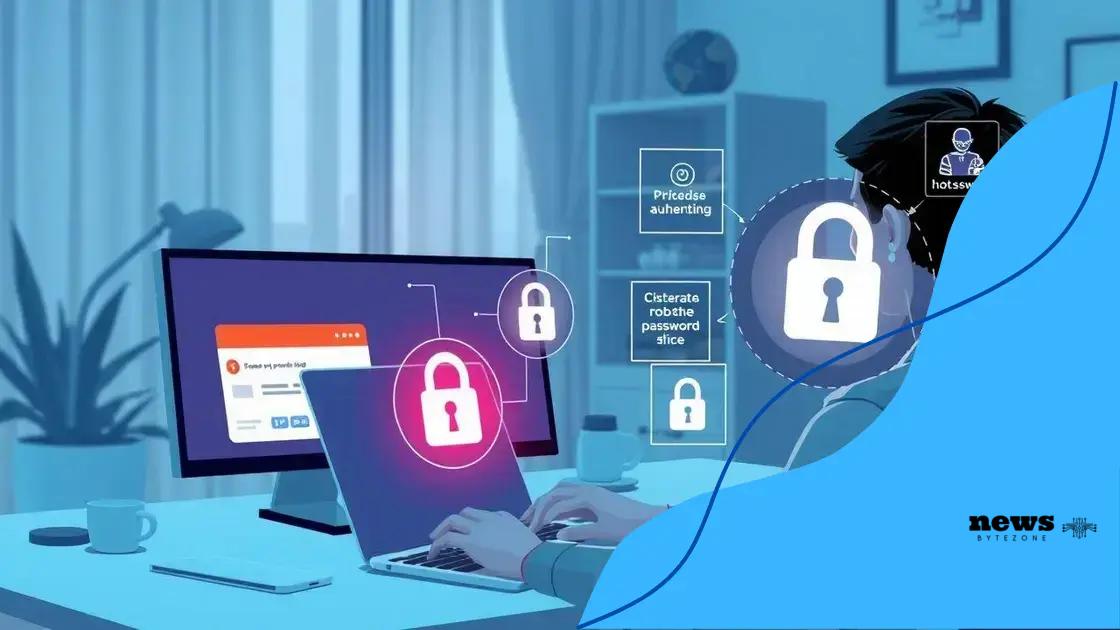Digital payment innovations enhance convenience but introduce fraud risks like phishing, account takeover, and card not present fraud; implementing best practices ensures security during online transactions.
Digital payment innovations have transformed the way we conduct transactions, making them quicker and more convenient. But with these advancements come new challenges, particularly in the realm of fraud. Are you aware of the risks that accompany these modern solutions?
Understanding digital payment innovations
Understanding digital payment innovations is essential in today’s fast-paced world of finance. With the rise of technology, payments have become more convenient than ever. From mobile wallets to cryptocurrency, these innovations offer numerous benefits, but they also bring unique challenges.
Types of Digital Payment Innovations
Several forms of digital payment innovations have emerged, allowing consumers to make transactions swiftly and securely.
- Mobile Payments: These allow users to pay with their smartphones, making transactions quick and accessible.
- Contactless Payments: Utilizing NFC technology, customers can pay by simply tapping their cards or devices.
- Cryptocurrency: Digital currencies like Bitcoin offer new ways to transact without traditional banks.
- Peer-to-Peer Payment Apps: Apps like Venmo and PayPal enable users to send money instantly to friends and family.
The evolution of these payment systems has brought about significant changes in how we view financial transactions. Consumers appreciate the ease and speed of these methods. However, they must also be aware of potential risks, such as fraud and security breaches. These issues can compromise personal information if users are not cautious.
Benefits of Digital Payment Innovations
In addition to providing convenience, digital payment innovations also offer other advantages. For instance, lower transaction fees and faster processing times are significant benefits for both businesses and consumers. With fewer physical cash transactions, businesses can minimize costs associated with handling cash.
Trust in digital payment methods continues to grow, but education on security measures is vital. Users should always secure their devices and accounts, adopting practices like two-factor authentication for added safety. As technology improves, it becomes easier to stay protected while enjoying the benefits of these innovations.
The evolution of online transactions
The evolution of online transactions has changed how we handle money in major ways. With the rise of the internet, shopping and paying bills online became a new norm. Initially, online transactions were basic, using simple credit card entries. However, technological advancements have significantly enhanced the security and convenience of these methods.
Key Milestones in Online Transactions
Several pivotal innovations have shaped the online transaction landscape:
- Secure Socket Layer (SSL): This technology was a game changer, allowing secure data transmission over the internet.
- Payment Gateways: Platforms like PayPal and Stripe streamlined payment processes for businesses, ensuring safe transfer of funds.
- Mobile Payment Solutions: The introduction of apps like Apple Pay facilitated purchases through smartphones, enhancing ease of use.
- Blockchain Technology: This innovation, associated with cryptocurrencies, offers a decentralized way of conducting transactions, increasing transparency.
As we look at these changes, it is clear that user experience has been a driving factor. With each innovation, the goal has been to make transactions faster and more secure. Customers expect to complete their purchases with just a few clicks or taps.
The Impact of Technology on Online Transactions
The growing influence of technology on online transactions cannot be overstated. Innovations like artificial intelligence and machine learning help detect fraudulent activity in real time. These technologies analyze patterns and flag unusual transactions, protecting consumers and businesses alike.
Moreover, the shift towards mobile and contactless payments reflects changing consumer preferences. People prefer quick and accessible solutions to traditional cash or check payments. This shift has led to greater competition among payment service providers, further driving innovation in the sector.
Common fraud risks in digital payments

Understanding the common fraud risks in digital payments is crucial for consumers and businesses alike. As online transactions multiply, so do the methods that fraudsters use to exploit vulnerabilities. Knowing these risks can help individuals take informed actions to protect themselves.
Types of Fraud Risks
Fraud in digital payments can take many forms, each with its own methods and consequences. Here are some notable types:
- Phishing Attacks: Fraudsters often trick users into revealing personal information through fake websites or emails.
- Account Takeover: Attackers gain access to a user’s account and conduct unauthorized transactions.
- Card Not Present Fraud: This occurs when criminals use stolen card details to make online purchases without the physical card.
- Transaction Fraud: Fraudsters manipulate payment systems to achieve fraudulent transactions, sometimes exploiting technical loopholes.
Each of these risks poses serious threats to consumers’ finances and can result in significant losses. Awareness of these methods can empower individuals to be vigilant.
How to Protect Yourself
While the risks are high, there are effective ways to protect against fraud. Implementing strong security measures is vital to safeguard your financial data. Here are some recommendations:
- Use Strong Passwords: Always use complex passwords and change them regularly.
- Enable Two-Factor Authentication: This adds an extra layer of security by requiring a second form of verification before access.
- Monitor Account Activity: Regularly check your transaction history to spot any unauthorized actions quickly.
- Educate Yourself: Stay informed about the latest scams and fraud methods to recognize potential threats.
By being proactive, consumers can significantly reduce their chances of falling victim to these fraud risks. Awareness, combined with strong security practices, creates a formidable defense against digital payment fraud.
Impact of technology on fraud prevention
The impact of technology on fraud prevention is significant in today’s digital payment landscape. As online fraud becomes more sophisticated, technology is evolving to stay one step ahead of fraudsters. Innovations in technology play a crucial role in safeguarding transactions and enhancing security measures.
Advanced Security Technologies
Modern fraud prevention relies on several advanced security technologies:
- Machine Learning: Algorithms can analyze transaction patterns to identify unusual activity, helping to prevent fraud before it occurs.
- Biometric Verification: Fingerprint and facial recognition technologies provide an additional layer of security, making it harder for fraudsters to access accounts.
- Blockchain Technology: By providing a tamper-proof ledger, blockchain enhances transaction transparency and reduces fraud risk.
- Anti-Fraud Solutions: Companies use sophisticated software that constantly monitors transactions for anomalies, alerting users to potential fraud.
These technologies improve security in digital payments, making them more reliable and less susceptible to fraudulent activities. The integration of these systems enhances not only consumer confidence but also the overall integrity of digital transactions.
Real-Time Monitoring and Alerts
Real-time monitoring systems have transformed how fraud prevention is managed. Financial institutions can now track transactions as they occur, allowing immediate intervention if suspicious activity is detected. Customers receive alerts about unusual transactions, which empowers them to take swift action if necessary. The combination of these technologies ensures that even if a fraudulent attempt is made, measures are in place to minimize damage.
The consistent evolution of technology continues to create opportunities for more robust fraud prevention strategies. As these tools advance, they adapt to new fraud patterns, making it increasingly difficult for fraudsters to succeed. Embracing these technological advancements is essential for both businesses and consumers to protect their financial interests.
Best practices for secure digital payments
Implementing best practices for secure digital payments is essential for everyone engaging in online transactions. As online payment methods become more common, the need for enhanced security measures grows. By following some straightforward guidelines, users can protect their financial information while enjoying the convenience of digital payments.
Essential Security Measures
Here are some key security measures to consider:
- Use Secure Connections: Always make transactions over secure connections (look for HTTPS in the URL) to protect data.
- Keep Software Updated: Regularly update your operating system, browser, and security software to guard against vulnerabilities.
- Monitor Accounts Regularly: Frequently check your bank and credit card statements to catch any unauthorized transactions early.
- Educate Yourself on Scams: Being informed about the latest scams can help you spot potential threats and avoid them.
These measures create a robust defense that can help shield users from fraud. In addition, utilizing different software solutions can automate some of these processes, making it easier to remain vigilant.
Choosing Reliable Payment Methods
Selecting trustworthy payment methods is just as crucial. Here are some tips for making safe choices:
- Stick to Reputable Platforms: Use well-known payment processors that offer built-in fraud protection.
- Check Reviews and Ratings: Research any new payment services before using them to ensure they have a solid reputation.
- Utilize Virtual Cards: Use virtual cards for online shopping to add an extra layer of security.
- Limit Public Wi-Fi Use: Avoid making payments over public Wi-Fi networks to prevent data interception.
By following these best practices, individuals can significantly reduce the potential risks associated with digital payments. Layering these security measures ensures a safer and more secure experience for every online transaction.
FAQ – Frequently Asked Questions about Digital Payment Security
What are the most common risks associated with digital payments?
Common risks include phishing attacks, account takeover, card not present fraud, and transaction fraud that exploit vulnerabilities in online systems.
How can I protect myself when making digital payments?
You can protect yourself by using secure connections, keeping your software updated, monitoring your accounts regularly, and using strong passwords.
Why is it important to use trusted payment methods?
Using trusted payment methods provides better security and built-in fraud protection, reducing your risk of financial loss.
What should I do if I suspect fraud on my account?
If you suspect fraud, immediately contact your bank or payment provider, change your passwords, and monitor your account for any unauthorized activity.

 Financial implications of remote work on urban economies
Financial implications of remote work on urban economies  Micro-investing: making the stock market accessible to everyone
Micro-investing: making the stock market accessible to everyone  The Gig Economy: Financial Planning for Freelancers
The Gig Economy: Financial Planning for Freelancers